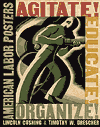September 2009
In other news, today the building will be lit red and yellow in honor of the 60th anniversary of communist China.

The Social Role of the Graphic Designer
Pierre Bernard, co-founder of Grapus and Atelier de Création Graphique, delivered this lecture in Minneapolis in 1991. It was reprinted in Essays on Design I: AGI’s Designers of Influence, London 1997.
Artists have for a long time been heading for ghettos, whether rich or poor. Other people have been subjected to a major mass-media aesthetic — or for the most underprivileged — to its leftovers. Our Western society is working at two different speeds. For the minority, a world of calm has come into being in which design means authentic quality. Art can be part of every life. It is a world in which a materialised and human reality can develop.
For the rest — the majority — what is offered is exactly the opposite. Art is something to be visited in reservations, and spiritual harmony is to be found in other realms, religious or chemical.
Inequality is on the increase. The humanist dream of a unification of our planet’s history in the capitalist logic of multinationals has in practice become a reductive standardization. It has thus been deemed legitimate to give arts and artists the function of entertainment and decoration, while techniques and technicians take care of efficient production.
This division of labour amounts to a complete capitulation as regards the principles on which design is founded. The division between the artist as creator and the artisan as technician has been born again out of the ashes of those founding principles. It marks a return to the Stone Age.
I believe that the single identity of the artist and the technician in the person of the graphic designer forms the basis for his capacity to assert his role strongly — and to take his own specific action as an individual who is a part of civilization. I believe that the social function of the graphic designer is a subject to be approached through opinions and persuasion rather than through logic and knowledge.
“Life will always be hard enough to prevent men from losing the desire for something better,” Maxim Gorky said. The graphic designer’s social responsibility is based on the wish to take part in the creation of a better world. It seems simple to declare such a principle, but given the contradictions of real life, the principle does not lead readily to practical rules of behaviour.
Continue reading "The Social Role of the Graphic Designer" »
Agitate! Educate! Organize!

My interview with Lincoln Cushing, co-author of Agitate! Educate! Organize!: American Labor Posters is up at Design Observer along with a brief slideshow of selections from the book.
We talk about the book, its origins, and the trouble with political posters.


